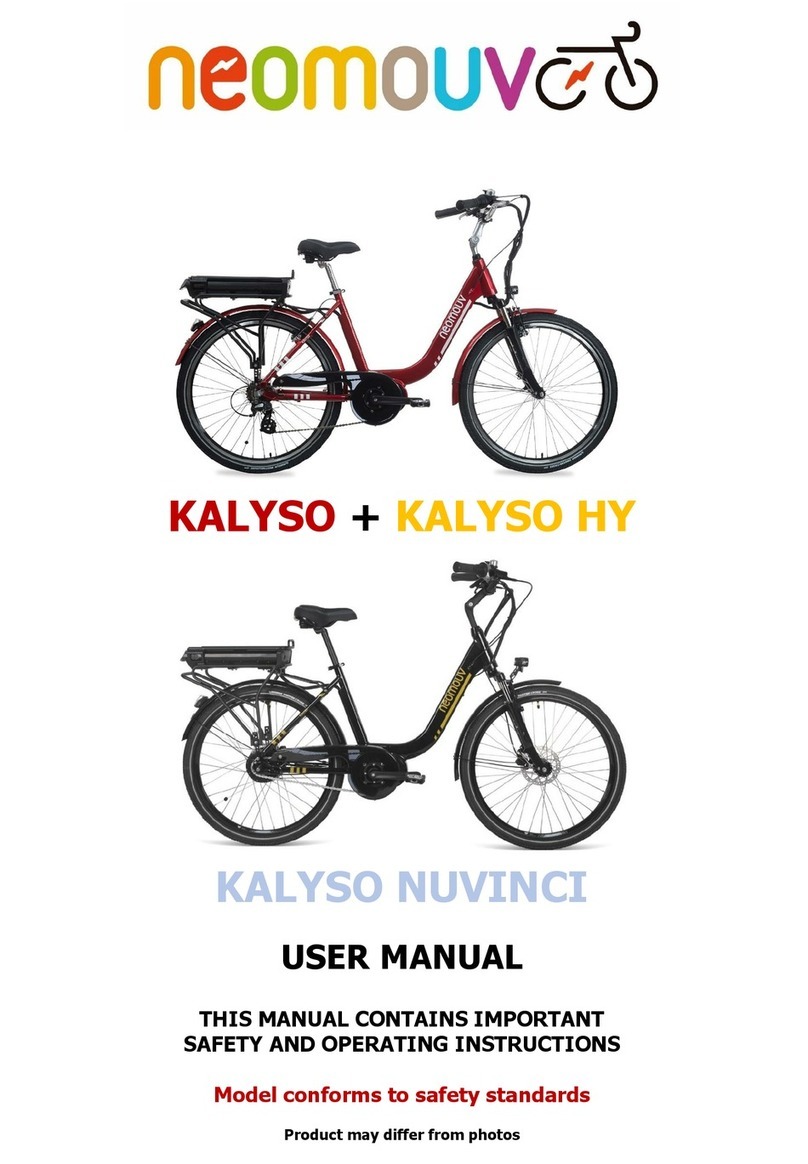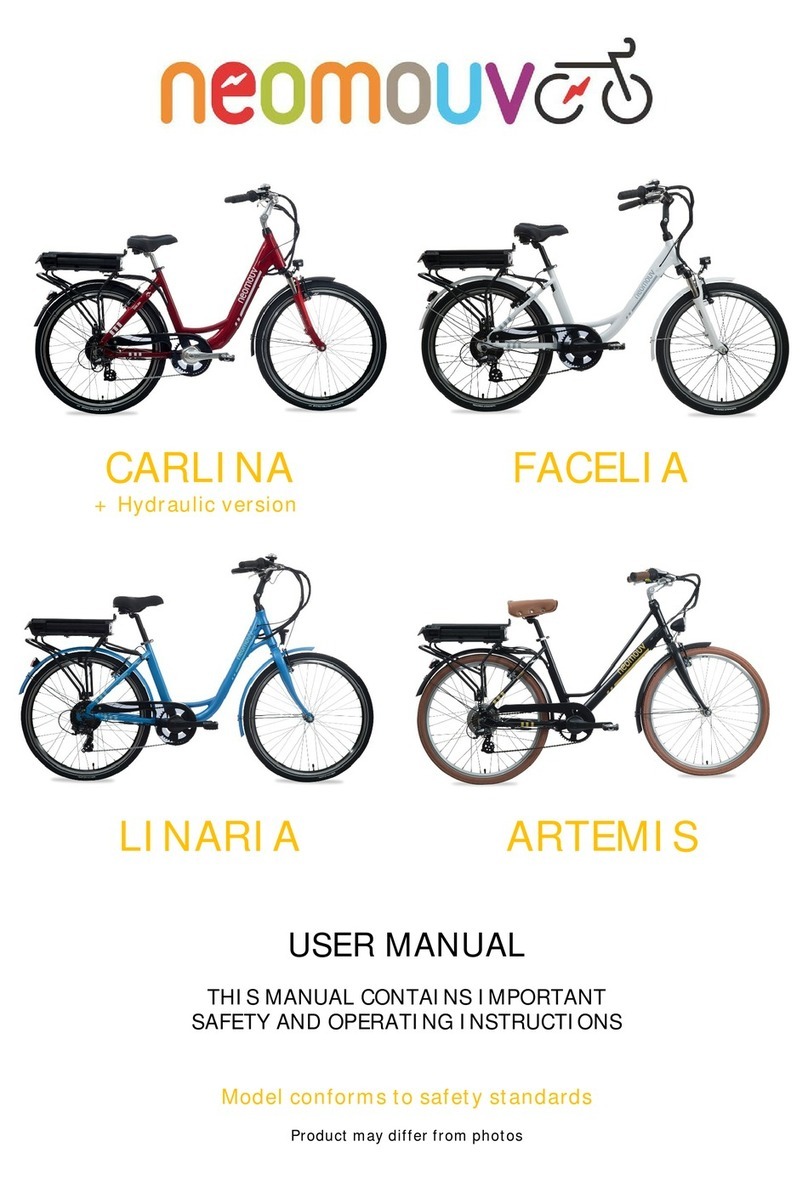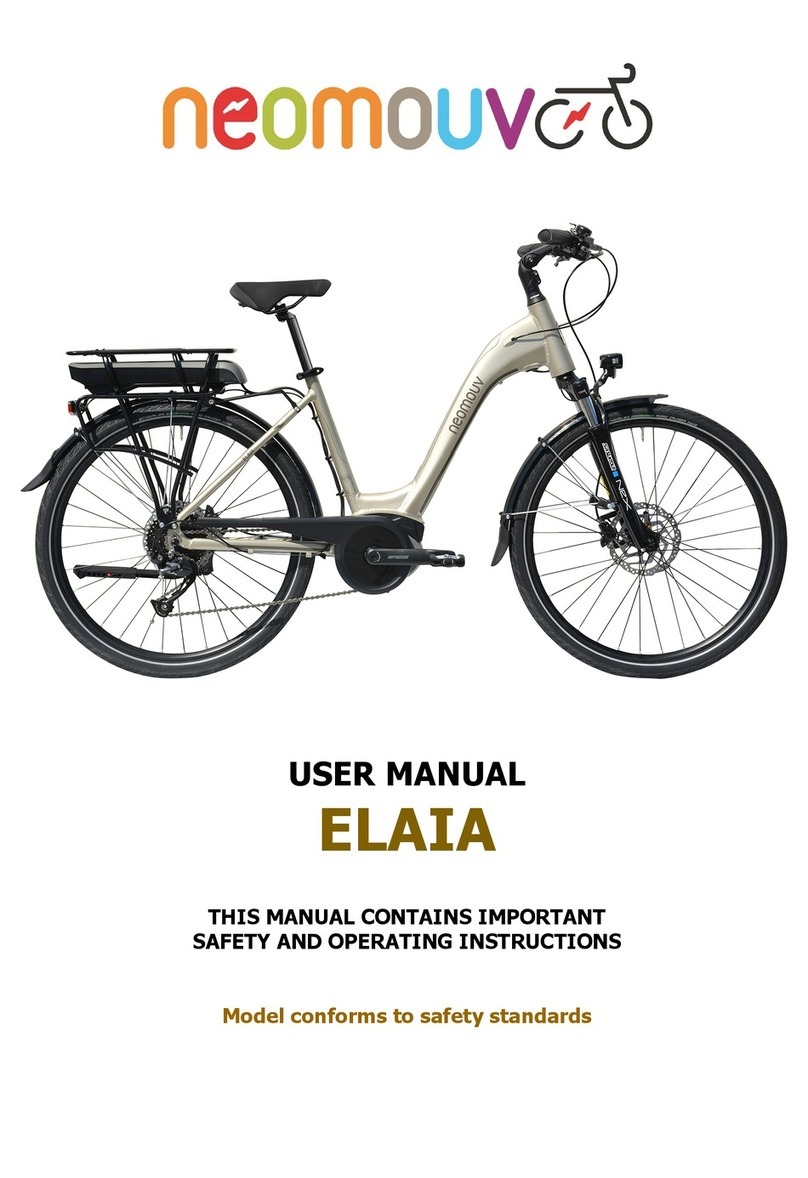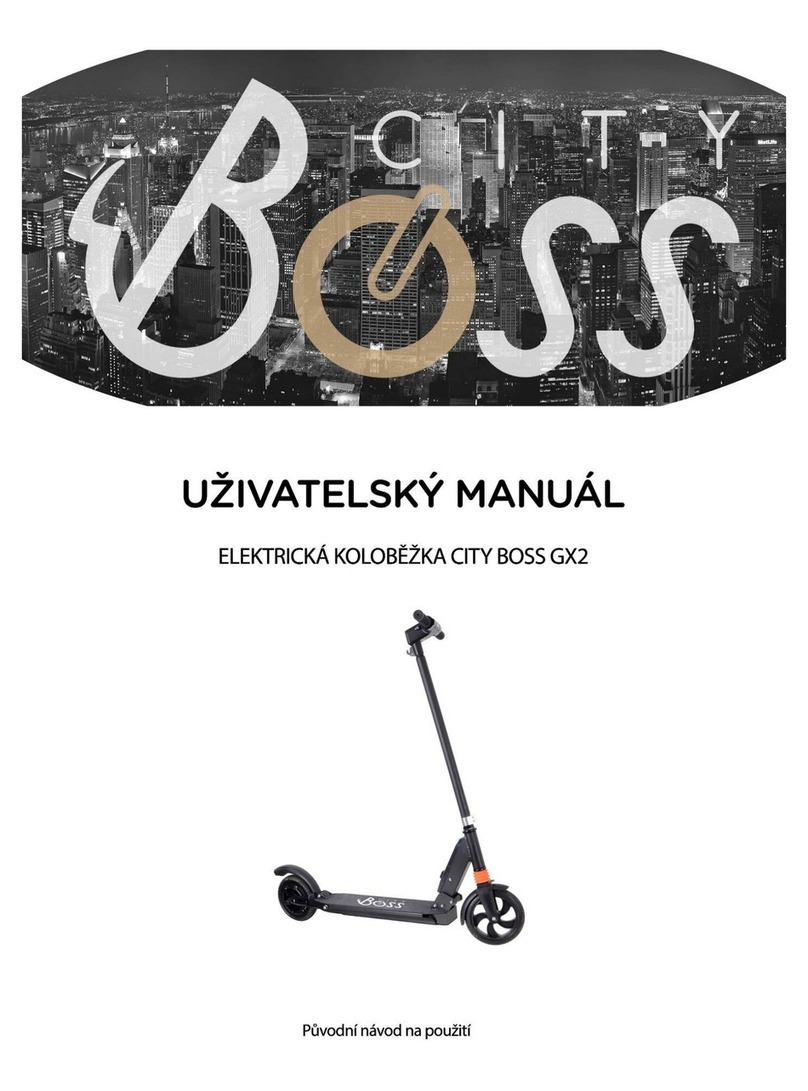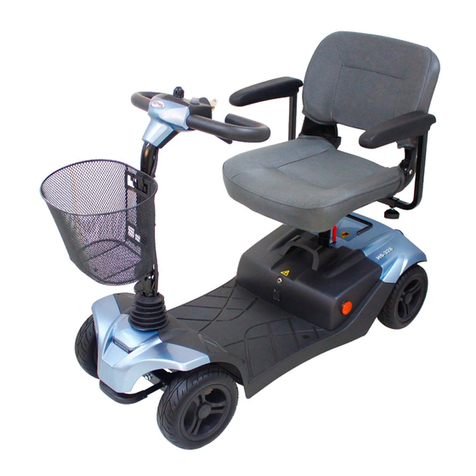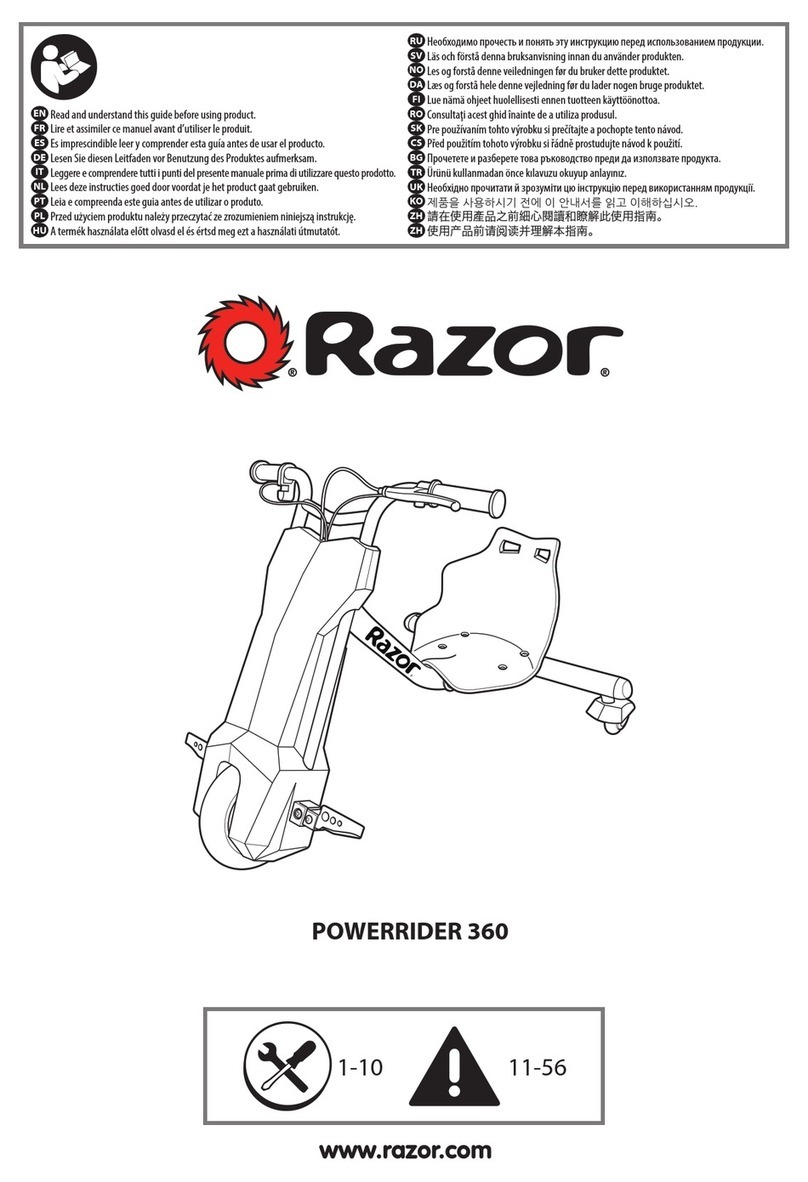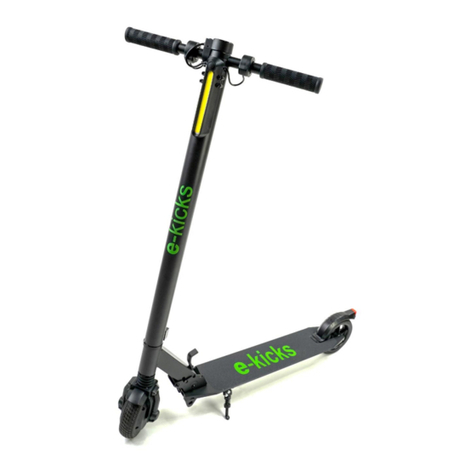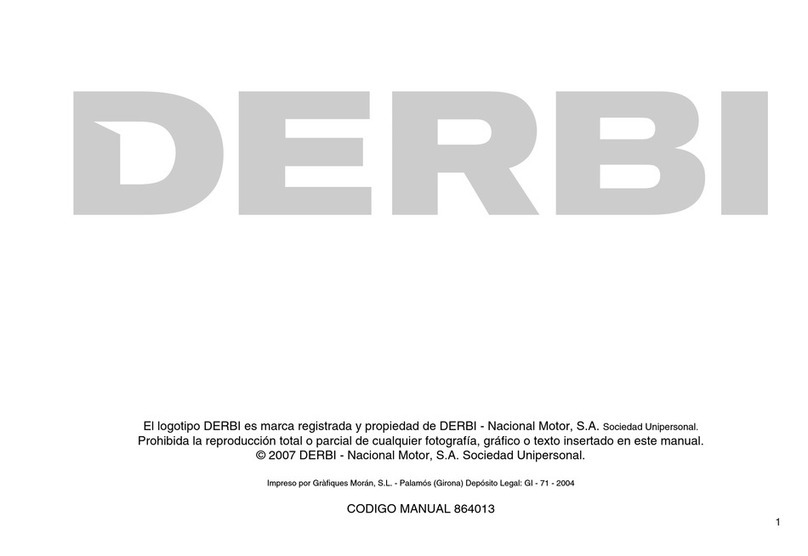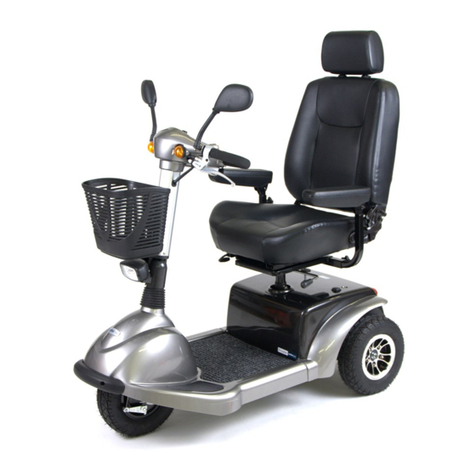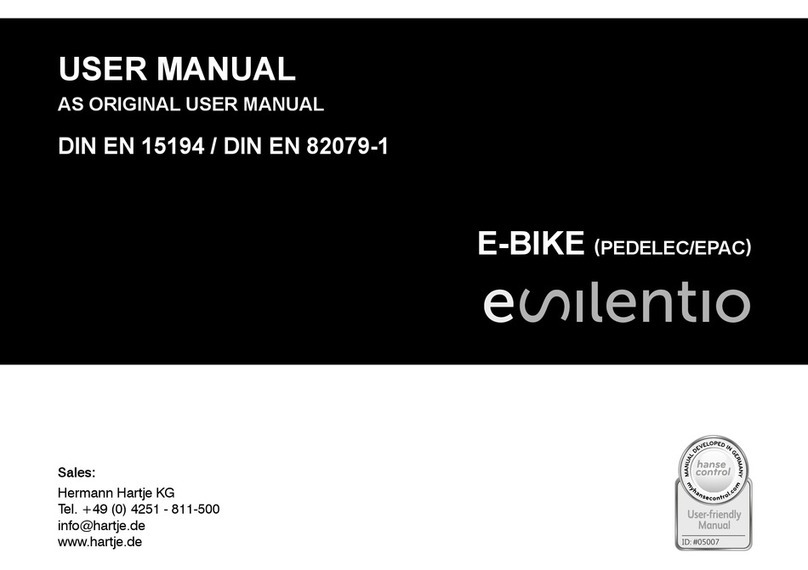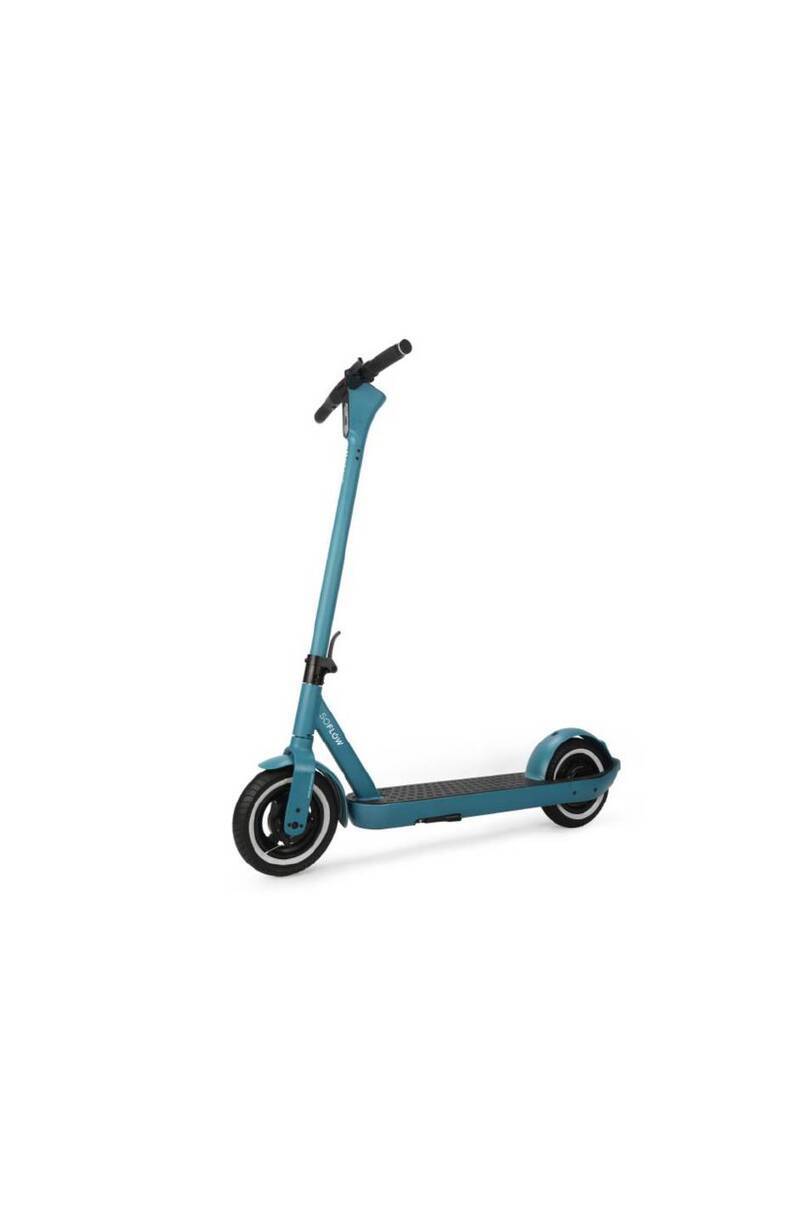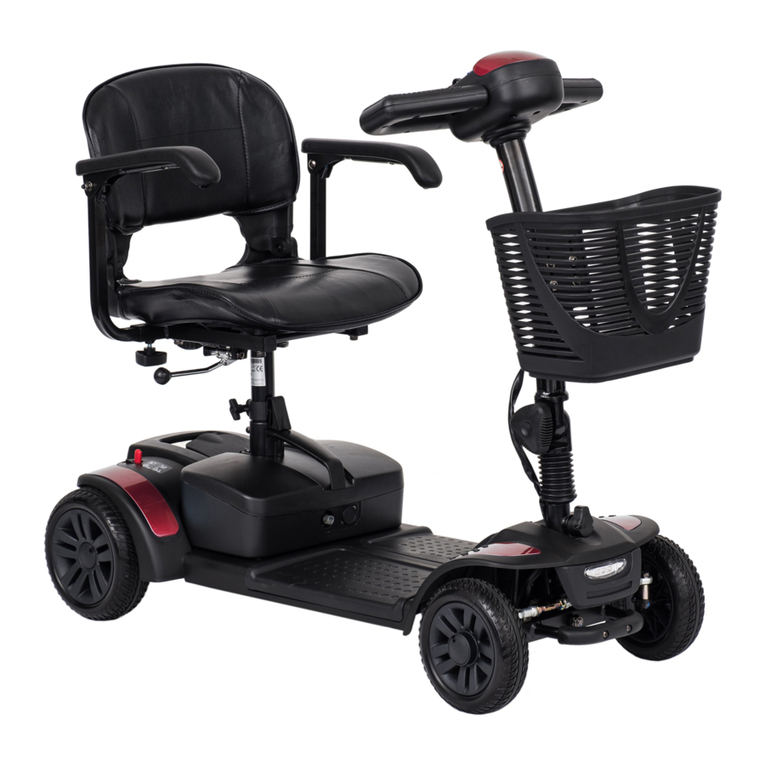neomouv NOVA S User manual

NOVA S MOUNTAIN S
ENARA S
USER MANUAL
THIS MANUAL CONTAINS IMPORTANT
SAFETY AND OPERATING INSTRUCTIONS
« Model conforms to safety standards »
Photos and data are not binding
MAJ : 05-2020

Manuel NOVA S –MOUNTAIN S –ENARA S
2
CONTENTS
1- INTRODUCTION : ...........................................................................................................3
2- SETUP : .............................................................................................................................4
2.1 Saddle settings : ............................................................................................................. 4
2.1.1 Tilt :.......................................................................................................................... 4
2.1.2 Height :..................................................................................................................... 4
2.2 Adjusting the hydraulic brakes :...................................................................................... 5
2.3 Removing and replacing wheels :.................................................................................... 6
2.3.1 Front wheel :........................................................................................................ 6
2.3.2 Rear wheel : ............................................................................................................ 6
2.4 Lights :.......................................................................................................................... 7
3 - UTILISATION DU VAE : ...................................................................................................7
3.1 Indexed gear shifting :................................................................................................... 7
3.2 Changing the level of assistance : .................................................................................... 7
3.3 The display and controls : ............................................................................................. 8
3.4 The electric assist : ........................................................................................................ 9
3.4.1 Function :................................................................................................................ 9
3.4.2 Performance :.......................................................................................................... 9
3.4.3 Technical Specifications of the assistance system :................................................... 10
3.4.5 The electric motor :................................................................................................ 10
4 - CHARGING THE BATTERY : ...........................................................................................11
4.1 36 Volt charger :........................................................................................................... 11
4.1.1 Precautions - safety instructions : ........................................................................... 11
4.1.2 Protecting the charger :.......................................................................................... 11
4.2 The battery : ................................................................................................................ 12
4.2.1 Ebike battery performance : ................................................................................... 13
4.2.2 Recommendations / Care of Your Battery : .............................................................. 14
5 - TIPS FOR INCREASING THE BATTERY LIFE PER CHARGE:...........................................15
6 - CARE AND MAINTENANCE : ..........................................................................................15
6.1 Care :........................................................................................................................... 15
6.2 Lubrication : ................................................................................................................. 15
6.3 Maintenance :............................................................................................................... 16
7 - SECURITE –RECOMMANDATIONS : .............................................................................16
8 - TECHNICAL DATA ..........................................................................................................17
9 - STATEMENT OF CONFORMITY ......................................................................................19
10 - TERMS OF WARRANTY ................................................................................................19

Manuel NOVA S –MOUNTAIN S –ENARA S
3
1- INTRODUCTION :
Thank you for choosing a NEOMOUV electric bike
Ebike overview :
Notes :
•The sign indicates important tips and mandatory security measures. Follow the various instructions.
•Some adjustments require specific assembly/disassembly and skill; do not perform if you are not
experienced, consult your authorised dealer or specialist.
•The sign shows tools that will be needed for tuning operations.
•Your Ebike has an engraved serial number on the frame.
Maximum load: 120 kg. For your safety it should not exceed the maximum load when using your
bicycle.
Battery
Electric motor
Pedal
sensor
Display
potence
Serial number
Rack

Manuel NOVA S –MOUNTAIN S –ENARA S
4
2- SETUP :
2.1 Saddle settings :
Allen key 6 mm
2.1.1 Tilt :
Loosen the nut under the seat.
Adjusting the angle of the seat, to obtain the position best suited to your comfort. Tighten the nut torque 13
Nm max.
2.1.2 Height :
The electric bike allows a lower seat position than on a conventional bike. With electric assistance you require
less effort and you can sit down for better stability. The optimum height of the rider for best use is between
1.65 and 1.90 m. So, adjust your saddle height in the sitting position as follows:
Loosen the quick release of the seat clamp :
Sitting on the saddle in suitable footwear for cycling, place a pedal in the down position, place one heel on a
pedal, the leg should normally fall without being stiff. Raise or lower the seat to get the proper height.
To calculate the height, you can also apply the formula HS (saddle height) =0.885xIL (inside leg). To measure
the inside leg height, stand with bare feet and heels five centimetres apart. Place (without pressing too hard) a
stick against your perineum, and then measure the height from the ground to the stick. This gives you the (inside
leg) value.
Tighten the quick release of the seat clamp.
Nut
Quick
Release

Manuel NOVA S –MOUNTAIN S –ENARA S
5
THE SEAT TUBE SHOULD NOT COME OUT BEYOND THE ETCHED SAFETY MARK (VERTICAL BARS).
The minimum height between the high point of the saddle and the ground is 85 cm.
2.2 Adjusting the hydraulic brakes :
Allen key 5 mm
Screwdriver
Your EBike can be equipped with front and rear hydraulic disc brakes. The maintenance of this system is the
responsibility of a specialist. However here are some recommendations for use :
-Periodically check the state of the pads. Avoid changing pads at the last moment. When the lining is
worn, the disc rubs against pads and damage to the disk can occur.
Here are two ways to check for wear:
•When the sound appears metallic during braking, the surface of the pad is worn.
•Visually, you can check to see the thickness of the pad surface by standing in front of the stirrup.
-Periodically check the cleanliness and disc wear. To clean discs use water or alcohol.
-Absolutely avoid contact with an oil on the disk or pads. If contact occurs, it is essential to change the
pads. (They are porous and will therefore absorb oils).
In general, WHEN HANDLING THE HYDRAULIC DISC BRAKE SYSTEM, DO NOT IMPROVISE.
We recommend you seek expert help when in doubt.
Security mark
Disc
Pads

Manuel NOVA S –MOUNTAIN S –ENARA S
6
2.3 Removing and replacing wheels :
2.3.1 Front wheel :
Removing the front wheel :
-You must first loosen the wheel fixings.
-Once this is done, the wheel must be slid forward to remove it.
-Insert the plastic spacer into the calliper (between the two pads).
-DO NOT SQUEEZE THE BRAKE LEVER WHILST THE WHEEL IS REMOVED.
Replacing the front wheel :
-Carry out the assembly operations in reverse order. Make sure that the wheel attachment is tightened
and aligned.
-Once the wheel is in place, operate the brake lever 3-4 times. This allows the pads to be properly
aligned.
-Check that the brake disc is centred and rotates without friction.
-Finally, check that the brakes are working properly.
2.3.2 Rear wheel :
Removing the rear wheel :
-Loosen the quick-release clamp.
-Pull the wheel forward and remove the chain from the wheel axle.
-Insert a plastic spacer in the calliper (between the two pads).
DO NOT SQUEEZE THE BRAKE LEVER WHILST THE WHEEL IS REMOVED
Replacing the rear wheel:
-Remove the plastic spacer from the calliper.
-Take the wheel and place the chain on the small sprocket on the right side, then engage the wheel
between the brake pads.
-Moving backwards, insert the wheel axle into the right and left housing of the frame. Tighten the quick
release.
Checking the wheel alignment :
-Centre the wheel in relation to the frame.
-Check the centring and positioning in line with the front wheel, as well as the positioning of the chain.

Manuel NOVA S –MOUNTAIN S –ENARA S
7
Checking the brake adjustment :
-Engage the brake lever 3-4 times. This allows the brake pads to adjust properly.
-Check that the brake disc is well centred and rotates without friction.
-Finally, check that the brakes are working properly.
2.4 Lights :
Your bike comes with lights as standard :
❖Fixed front and rear lighting. The front lights (example) and rear (example) are
powered by the battery.
ALWAYS KEEP YOUR LIGHTING CLEAN AND IN GOOD CONDITION.
Lighting is mandatory at nightfall.
3 - UTILISATION DU VAE :
3.1 Indexed gear shifting :
Your gear change consists of a derailleur and 9 sprockets.
The smallest sprocket with 14 teeth allows you, in easy conditions (slight downhill, flat), to increase your
speed.
The intermediate sprockets are to be used in normal conditions.
The largest sprockets with up to 34 teeth will assist you on hill climbs and start-ups.
The gear selector (indexed) is located near the right handlebar grip on the handlebar, operate it to choose one
of the 9 pre-set positions.
3.2 Changing the level of assistance :
Your bike is equipped with 3 levels of electronic assistance:
Shifter

Manuel NOVA S –MOUNTAIN S –ENARA S
8
1. Eco Position = minimum assistance.
2. Normal Position = medium assistance.
3. High Position = maximum assistance. In this position your Ebike provides the greatest assistance
but also consumes the most energy.
To scroll through the assistance levels, press the UP or DOWN buttons on the assistance selector
located near the left handlebar grip.
3.3 The display and controls :
NB: the display can be removed by pressing on the tab and sliding it on the rail.
Start assist: Holding down the "DOWN" button (located under the control) will trigger the starting aid
which allows the EBike to start without pedaling.
More info on the SHIMANO 6100 series visit: https://si.shimano.com/pdfs/um/UM-78N0A-001-00-
FRE.pdf and for the 7000 : https://si.shimano.com/pdfs/um/UM-79E0A-005-FRE.pdf
Clock
Speed
information
Kilometres
travelled
ON-OFF button
UP Button
Increases the level of
assistance
DOWN button
Decreases the level of
assistance
MODE button

Manuel NOVA S –MOUNTAIN S –ENARA S
9
3.4 The electric assist :
3.4.1 Function :
Your bike is electrically assisted: it is equipped with an electric motor, located in the rear wheel. This motor
starts automatically (if the ignition is switched on and the battery is charged) when you pedal and only when
you pedal (except with the "walk assist button").
The assistance is activated by an electromagnetic sensor that cuts the power to the motor when the pedals
stop turning.
The motor also shuts off :
•When you apply one of the two brakes ;
•When you reach the assisted speed limit of 25 km/h ;
This principle allows the motor to give you full power when you need it and saves battery power when you're
on a downhill run or on flat ground.
This energy management allows a longer range and are performed by the electronic controller.
Please be aware that activating or stopping the assistance may result in sudden acceleration
or deceleration.
3.4.2 Performance :
The assisted speed of your bike is limited to 25 km/h. At this speed the power to the motor is automatically
cut off.
The assisted range of your bike depends on several parameters:
❖The weight carried :
The performance of your bike is based on an average rider of 75 kg.
❖The outside temperature :
The performance is based on an outside temperature of about 20°C. Below this temperature the
performance decreases; however, this decrease is only really noticeable below 5°C.
❖Battery wear :
Your battery is designed to deliver stable performance for 750 charge/discharge cycles (or 3 years
average use). After these 750 cycles, it is still operational, but its’ performance, and therefore your
range, decreases proportionally.
❖Above all, range depends on the nature of your route :
Theoretical range is defined as a quasi-continuous motor load on flat or gently undulating ground (10
to 20% gradients). If your course is flat and includes a percentage of descents (even slight ones), your
range is increased. If you climb hills of more than 5% (the motor "barely" goes up more than 8%),
your range may decrease proportionally

Manuel NOVA S –MOUNTAIN S –ENARA S
10
3.4.3 Technical Specifications of the assistance system :
Motor : SHIMANO –250 watts
Battery : Lithium Ion 36 V –418Wh
Battery life : 750 complete charge/discharge cycles under normal charging conditions.
Range : 70 to 80 km
(For a 75 kg rider at a speed of 18 km/h in Eco mode).
3.4.5 The electric motor :
The Shimano electric motor is located in the bottom bracket. It requires no maintenance on your part and is
covered by a 2-year manufacturer's warranty. After 3 years or 25,000 kilometres, we advise you to have it
serviced by an authorised dealer or specialist. Although it is designed to be water resistant, we do not
recommend cleaning it with a high-pressure jet.

Manuel NOVA S –MOUNTAIN S –ENARA S
11
4 - CHARGING THE BATTERY :
4.1 36 Volt charger :
CHARGER SPECIFICATIONS
Model 36 V
6498
Smart charger for Lithium Ion battery
For more info on the charger : https://si.shimano.com/pdfs/um/UM-78N0A-001-00-FRE.pdf
The charger that comes with your bike complies with CE manufacturing standards, and the environmental
protection standards IEC/EN 60335-1. It has been specially designed to recharge the battery of your electric
bike. It will fully charge your battery in 4 to 6 hours depending on the ambient temperature and battery wear.
This so-called "slow" charging time is voluntary, in order to preserve the life of your battery.
Its operation is simple: connect the charger's output plug to the socket on your battery and then connect the
plug to the mains.
4.1.1 Precautions - safety instructions :
•Do not connect the charger plug to the mains with wet hands (danger of electric shock).
•All charging must be carried out in a ventilated room.
•Always make sure the charger is compatible with the local power supply.
•Do not charge the unit in a humid environment or near flammable or explosive products (any charge
that generates heat diffusion: fire or explosion hazard).
•Do not store the unit hot.
•Do not charge a defective or dead battery.
•Keep the charger and its’ connections out of the reach of children.
•Do not attempt to disassemble the charger
4.1.2 Protecting the charger :
•Do not expose it to rain.

Manuel NOVA S –MOUNTAIN S –ENARA S
12
•Do not leave the charger disconnected from the power supply (220 volts) and connected to the
battery.
•Do not submerge it.
•Do not place any object on the charger or cover it.
•Take care of the charger's input and output wires.
•To protect the charger after a long charge (more than 24 hours) unplug the electrical connection and
leave the unit in a dry, ventilated place.
•Avoid leaving the charger connected to the mains for more than 24 hours
WARNING: For your safety, DO NOT open the charger (risk of electric shock - high voltage).
Contact your dealer if you have any problems with the charger.
FOR YOUR SAFETY, SEE ALSO THE PICTOGRAMS ON THE BACK OF THE CHARGER.
1) Complies with EC standards
2) Double insulation
3) Do not dispose of with household waste.
4) Respect the polarity
4.2 The battery :
Your battery has a serial number, you can find it at the base of the battery.
Your battery is assembled in a special case. DO NOT attempt to open or disassemble it. Any breach of the
warranty label will automatically result in the cancellation of the warranty.
To remove the battery from the battery compartment, unlock the it with the key and tilt the battery to the
side of the bike.
To replace the battery, first position the bottom of the battery correctly and then flip the battery back into the
battery compartment
You can recharge your battery while it is still on the bike or remove it from its holder and then charge it,
always through the socket on the back of the battery.
For safe charging, first connect the charger to the battery and then connect the standard charger plug to the
mains (220V/50 Hz).
Check that the charger is working properly (see section 4.1).
Battery lock

Manuel NOVA S –MOUNTAIN S –ENARA S
13
4.2.1 Ebike battery performance :
Batteries are consumable components and have a limited lifespan: over time, their capacity and performance
diminish, and must be replaced. Ageing of the battery may therefore contribute to changes in Ebike performance.
How to optimise battery performance :
Battery life is the length of time the Ebike can operate before it needs to be recharged. The "life of the battery" is
the length of time before it needs to be replaced.
It is related to its "chemical age" which is composed of :
•The age of the battery
•The number of charge cycles (no need to completely empty the battery each time since there is no memory
effect)
•The maintenance the battery has received
•The use of the bike: weight of the bike, the user and the material transported / mechanical condition of the
bike (tyre pressure, state of the transmission) / cadence of pedalling / relief of the course / outside
temperature
•The level of assistance chosen
The efficiency of the battery diminishes as its chemical age increases (follow the tips in the manual to optimize
battery performance and extend battery life.
Chemical ageing of batteries :
Chemical aging of a battery means that the time elapsed before it needs to be recharged is reduced. This range is
sometimes referred to as "maximum battery capacity".
When operation can no longer be assured with the full capabilities of the power management system, with low load,
high chemical age or low temperatures, the system will shut down to preserve the electronic components. Although
this shutdown is intentional from the point of view of the device, it may be unexpected for the user.
When the battery reaches a sufficiently advanced chemical age, the performance decreases and eventually the
battery must be replaced. To improve the performance of the Ebike, it may be useful to replace the battery (contact
your dealer).
Maximum capacity of your battery :
The maximum battery capacity is a measure of its’ capacity in relation to its new condition. A battery will lose
capacity as its chemical age increases, which may result in fewer hours of use between recharges.
A normal battery is designed to retain at least 70% of its original capacity after 2 years of use or 500 full
charge cycles under normal conditions of use and approximately 50% after 5 years (follow the
recommendations given in the manual).

Manuel NOVA S –MOUNTAIN S –ENARA S
14
4.2.2 Recommendations / Care of Your Battery :
•Avoid any proximity to sources of heat.
•Avoid any short circuit to the motor’s charging and plug connections.
•Only use the battery for its intended purpose.
•Do not expose the battery to temperatures higher than 40°C and lower than –20° C.
•Never drop the battery; put it in a stable place.
•Warning handle with care! There is a risk of short circuiting and overheating in the event of any impact
on batteries.
•Always check that the charger is compatible with the local power supply.
•When charging is finished, it is recommended to disconnect the charger from the battery.
•During periods when the bike is not in use, store the battery in a cool, dry place at a
temperature above 10° C and lower than 40° C.
•Never leave your battery completely discharged for longer than 3 days, as this may
damage it.
•In case of prolonged non-use, you must recharge the battery once every two months.
•Never leave the battery exposed to the sun for long periods of time.
•Never let a child play with or handle the battery.
•Never charge the battery in the rain or in damp surroundings.
•Never open the battery. Opening it may lead to a significant risk of electrocution and void the
warranty.
•Never spray the battery directly with water or any other liquid.
•Never submerge the battery.
•Only use the charger provided to charge your battery. Using any other charger that is not adapted for
the battery may result in an accident.
WARNING! In the case of very infrequent use of the battery (once every two months only), its
capacity will decrease much more rapidly than with regular use. The battery’s energy comes
from a chemical reaction that requires sufficiently regular activation to maintain its
effectiveness.
WARNING! You should not throw your battery or charger out with your household waste. A
collection system for this type of product has been set up in most towns, you can contact your
local council for further information. Electrical and electronic products contain hazardous
substances that are harmful to the environment or human health and should therefore be
recycled.
Read carefully the indications on the battery:
The battery provided with your e-bike conforms with:
•The standards EN61000-6-1 and EN61000-6-3;
•The UN38.3 directive on the transport of dangerous
goods;
•Directive 2006/66/EC;

Manuel NOVA S –MOUNTAIN S –ENARA S
15
5 - TIPS FOR INCREASING THE BATTERY LIFE PER CHARGE:
The range is approximately 70 to 80 km for a user weighing 75 kg at an average speed of 18km/h on a
journey in Eco mode.
In order to save battery, and therefore increase the autonomy of your bike, we offer some advice :
•At start-up: set power assistance to position 1 and choose a middle gear. If your route is uphill,
select a low gear and use the “walk assist” position.
•In traffic jams: set power assistance to position 1 and select a low or middle gear depending on the
frequency of the stops you will have to make.
•Hill start: before stopping, select a low gear, and then set the power assistance according to the
incline.
•Climbing a tougher hill: if you are climbing a hill and the speed becomes too low, you can opt for
more powerful assistance. You will then feel the power assistance increase. If this is insufficient,
select a lower gear (your energy consumption will be greater, and your battery range will be
reduced).
•Route without stops: if your route has no obstacles (no traffic lights, traffic jams or rough roads),
you can set your bike to cruising speed. Pick your assistance level and select a high gear. This will
allow you to go faster while saving energy.
•Downhill: stop pedalling (freewheel) or pedal normally, but without effort while adapting your speed
selection and let yourself move steadily.
•To prolong battery power: start up in position 1. Once your bike has started, set your assistance
level and select a high gear. Maintain a constant speed. Your battery charge will last longer.
6 - CARE AND MAINTENANCE :
6.1 Care :
To better preserve your bike, maintain it regularly:
- Check all settings, brake, lights and brakes.
- Clean and grease the bearings every 6 months.
- Clean your bike regularly.
When cleaning your bike with a sponge and soapy water, remember to rinse and dry the different parts of the
bike thoroughly to remove any standing water, thus avoiding early risks of corrosion. Do not use detergent,
gasoline or high-pressure spray.
6.2 Lubrication :
Lubricate the chain lightly and regularly (about once a month).

Manuel NOVA S –MOUNTAIN S –ENARA S
16
6.3 Maintenance :
Like any mechanical component, a bicycle is subject to high stress and wear. Different materials
and components may react differently to wear or fatigue.
If the service life of a component has been exceeded, it may break off in a single blow, possibly causing injury
to the cyclist. Cracks, scratches and discoloration in high stress areas indicate that the component has
exceeded its life and must be replaced.
DO NOT USE ANY LUBRICANT ON THE SURFACE OF THE RIMS OR TYRES.
Check the condition and correct operation of the signalling devices (e.g. bulbs etc.) and clean
them if necessary, with a dry cloth.
7 - SECURITE –RECOMMANDATIONS :
Regularly check the following points:
•Wheel tightening (25 Nm for the front, 25 Nm for the rear)
•Wear level of tyres (replace the tyre as soon as the wear indicator is reached) and adjust the tyre
pressure to 60 to 65 Psi-/ 2.8 to 4.5 bar. The tyres of your bicycle are compatible with the rim tape, no
modifications should be made to them, only suitable spare parts (tyres, inner tubes, brake friction
elements etc.) should be considered. Contact your dealer for more information.
•Check that the steering (6 Nm), pedals (20 Nm) and saddle (6 Nm) are tight.
Because of its weight and the inertia due to the motor, you should allow for longer braking distances when
riding your electric bike, especially in rainy weather.
Your electric bike is suitable for use in the city and for road trips.
On public roads, everybody who rides a bike must respect and apply the provisions of the highway code of the
country they are in as well as the legal requirements for this type of transport. (e.g. lighting, signalling,
wearing a helmet (recommended) reflective device etc.).
For the safe use of your bike, we recommend periodically checking and inspecting: the brakes (wear of the
pads), the condition of the wheel rims and spokes (wear of the wheel rims and spokes), the condition of the
tyres, the steering (fastenings, tightness of the wheel nuts) and all other parts specific to your vehicle. The
wheel rims must be smooth, without any cracks, breakage, or deformities. If you notice any anomaly with the
wheel rims, please get them checked immediately.
WARNING! Like any mechanical component, a bicycle is also subject to high levels of stress and wear.
Different materials and components may react differently to wear or erosion. If the predicted lifespan of a
component has been exceeded, it may break suddenly, potentially causing injury to the rider. Cracks,
scratches, and discolouration in areas that are subjected to high stress indicate that the component has
exceeded its lifespan and should be replaced.
For your safety, it is equally important to replace any critical components that are showing signs of wear or
any other problem (e.g., tyres, wheel rims, etc.) with original parts. Contact your dealer.

Manuel NOVA S –MOUNTAIN S –ENARA S
17
Do not sit on the bike when it is on its stand, as there is a risk that it may break, and
you could have an abrupt fall.
Stay alert; do not spend too much time looking at the bike’s display while you are riding.
For your safety, it is recommended to routinely have the bike lights on.
We strongly recommend that you wear a helmet.
Wearing a high-visibility vest is advisable when riding in rural areas, in traffic at night, or on days when the
visibility is poor.
8 - TECHNICAL DATA
PIECES MAXIMUM TORQUE (Nm)
Bottom bracket 40
Pedals 20
Front wheel axle 25
Rear wheel axle 25
Seatpost 6
Stem and hanger 6
Saddle angle 13

Manuel NOVA S –MOUNTAIN S –ENARA S
18
CHARACTERISTICS
NOVA S
MOUNTAIN S
ENARA S

Manuel NOVA S –MOUNTAIN S –ENARA S
20
SAS NEOMOUV
ZI Ouest - Allée des quatre Journaux
72200 LA FLECHE
contact@neomouv.com
SAS au capital de 1 200 000 € - RCS Le Mans 518 158 183
SIRET 518 158 183 00013 –APE 4649Z –TVA INT FR 91 518158183
NEOMOUV –reproduction interdite. NEOMOUV est une marque déposée. Le constructeur se réserve le droit de modifier les caractéristiques de ses
produits en vue d’ y apporter des améliorations techniques ou de respecter de nouvelles règlementations.
This manual suits for next models
4
Table of contents
Other neomouv Scooter manuals

